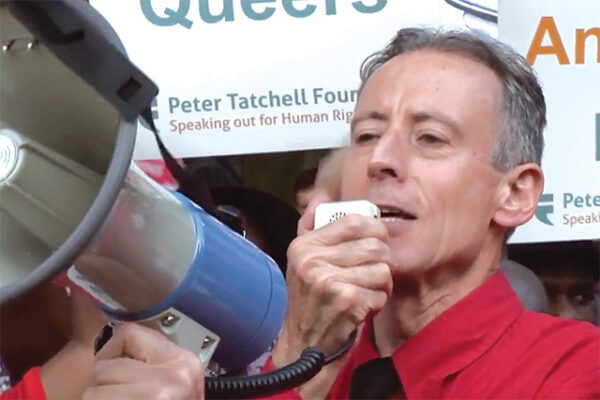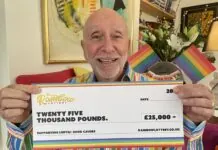Last in a series in which David McGillivray profiles some forgotten but fascinating gay pioneers. This week: MP and the poet…

WILLIAM BANKES: COUNTRY HOUSE RESCUE
As far as this series is concerned, he’s the oldest, the most forgotten, the most important. William Bankes was an early 19th century aristocrat with a taste for the finest things in life and the money to acquire them. One of the earliest Egyptologists, he made the only known records of monuments and hieroglyphs that were subsequently destroyed. His palatial stately home, Kingston Lacy, sitting in its 8,000 acres, is the biggest National Trust estate in the country. But all this counted for nothing because Bankes was known primarily as a sodomite. A history of Kingston Lacy written in 1900 made no mention that Bankes lived there, let alone re-modelled it and stuffed it with Old Masters and other antiquities. He was written back into the annals of history only very recently. The NT now describes Bankes as an illustrious member of his family, “artistic, adventurous and charming.” Yes, they’re euphemisms. The Trust can’t quite bring itself to use the word “gay.”


Bankes served as a Tory MP on and off from 1810 to 1834. But he wasn’t suited to political life. He first gave up his seat in 1812 to go travelling. Byron had told him that Greece and Albania were a “paradise of boys.” Bankes toured Europe and North Africa for seven years. Like Beckford he bought great paintings and shipped them back to England. He first visited Egypt in 1815. Ever since the Rosetta Stone had been exhibited at the British Museum in 1802, Brits had become fascinated by Ancient Egypt. Bankes sent many relics to Kingston Lacy and word spread about his pioneering research. In 1818 Thomas Young, who helped decipher the Rosetta Stone, wrote to Bankes asking him to look out for its missing pieces. (This letter is now part of the British Museum’s LGBT Trail. See QX 830).
After meeting up with Byron in Venice, another place in Europe where buggery was no big deal, Bankes returned to England and resumed his seat in Parliament. His life was uneventful until 1833, when he was arrested for “attempting to commit an unnatural act.” Bankes’ defence was that he had been on his way to the Commons when he felt the need to visit a public toilet. A night-watchman, who summoned a police constable to the scene, told a different story that included guardsman Thomas Flowers and the dress of both men being in disarray. When locals discovered that the suspects were in custody, a crowd of two thousand surrounded the police station, baying for blood. There had been similar high profile arrests earlier in the year. (These scandals inspired someone, possibly George Colman the Younger, to write “Don Leon”, a poem in the style of Byron, protesting that sodomy remained a capital crime. In the poem Bankes’ arrest is described along with the execution of Captain Henry Nicholls).

Bankes was fortunate that he had friends in extremely high places. One was none other than the Duke of Wellington, whom he’d met on his travels. On the day of Bankes’ trial, the Duke stated that his friend was “utterly incapable of such an offence.” The jury took ten minutes to return a verdict of not guilty. But Anne Sebba’s researches suggest that the Bankes/Flowers incident was “almost certainly the result of both seeking a sexual encounter.” The public toilet in question was in a cruising ground nowhere near Bankes’ route to the Commons.
In 1834 Bankes retired from public life and concentrated on the restoration of Kingston Lacy. But in 1841 he was in trouble again when another police constable, William Bennett, saw Bankes and an unnamed guardsman climb over railings into Green Park. The Times of 3rd September declared that what happened next was “unfit for publication.” Bennett spoke of several attempts at bribery culminating in Bankes offering him “all the money he had.” But the honest copper had stood his ground. Although the soldier had escaped, Bankes had been arrested. He was later released on £200 bail.
“Bankes was fortunate that he had friends in extremely high places.”
Events progressed rapidly. Bankes rushed to his solicitor, who advised him to get out of the country immediately. (The most recent execution for sodomy had been in 1835). On 13th September Bankes signed documents assigning Kingston Lacy and other properties to relatives. On 18th September he boarded a boat for Le Havre. (The UK had no extradition treaty with France until 1870). Bankes was charged in his absence that he “endeavoured to persuade a person unknown to commit and perpetrate that detestable crime (among Christians not to be named) called Buggery.” But thanks to Bankes’ solicitor, the Crown was never able to seize Kingston Lacy.

Nevertheless, Anne Sebba, in her book The Exiled Collector, believes that in 1854 Bankes saw Kingston Lacy one last time. One of his letters implies that he slipped over the Channel and personally approved the renovations. The following year he died in Venice of cholera. His body was returned to England for a secret funeral. There was only one obituary.
The Exiled Collector: William Bankes and the Making of an English Country House is out of print but copies are available on Amazon.
BRIAN HOWARD: TOO MUCH, TOO SOON
Plenty of people fail to realise their potential. But poet Brian Howard’s fall from grace was so spectacular that it inspired a 639 page book called Portrait of a Failure. If he’d lived, Howard may have approved that title. He wrote of himself, “My poems became incredibly affected, cerebral, self-confident and poor. At Oxford I wasted my time almost completely.” As with all the gay men in this series, he’s now forgotten; and yet none of the others has been written about by so many eminent people. They were fascinated and bewildered by his cataclysmic decline from greatness. When Portrait of a Failure was first published in 1968, many of his friends were still alive. They spoke despairingly of him. Poet W.H. Auden said, “He was, inside, I think the most desperately unhappy person I have ever known.” Where did it all go wrong?

Born in 1905, Howard was recognised early on as a boy of high intelligence and talent. At Eton he received a glowing notice for his role in a play (“Howard as Sybil Camberley showed a real dramatic power, and made an excellent leading lady.”) This praise was lost on his absentee father. Howard wrote in his diary, “Daddy objected to my taking the part of a girl in the play.” Aged 17 he and his schoolfriend Harold Acton edited a magazine, Eton Candle. Howard sent his early poems to Edith Sitwell, who acclaimed him “a born writer” and later published his work in her own annual anthology Wheels. “Alas, this rather turned my head,” Howard wrote.
In 1923 Howard and Acton went to Christ Church College, Oxford, where they, Evelyn Waugh, Robert Byron and others became the leading lights of the so-called Oxford Wits. They in turn were part of a much larger clique of party-loving socialites, the Bright Young People. Acton called Howard “exceptionally brilliant in his youth”, while Waugh wrote, “At the age of 19 he had a dash of insolence, a gift of invective and repartee far more brilliant than Byron, a kind of ferocity of elegance that belonged to the romantic era of a century before our own.” Unfortunately Howard’s bright young colleagues began to overtake him in the literary world.
Howard became discouraged. He threw himself into the sex, drug and party circuit, becoming notorious for his flamboyance and outrageous pranks. In 1927 it was probably he who set the Thames on fire during a party in Henley. The same year he went to Germany for revels with trannies and cocaine. In 1929 Howard and other bright young things including Evelyn Waugh and Diana Mitford put on an exhibition of abstract art said to be the work of Bruno Hat. Hat didn’t exist but most of the guests at the private view appear to have been taken in by the hoax.
Howard’s last substantial work, God Save the King, was published in 1931. From then onwards most of his writing was journalism, often for the New Statesman. He continued to travel, falling madly in love with a succession of working class lads who have never been identified. Because Howard was earning almost nothing, he was supported by his mother, who seems to have known everything about her son’s sexuality and may have paid for him to have psychiatric treatment. Howard wrote to her, “Certainly it isn’t a virtue to be a homosexual. As society is now constituted it is excessively inconvenient. But it certainly isn’t a vice. I myself am not, completely. I shall marry one day.”
“He was, inside, I think the most desperately unhappy person I have ever known.”
There’s no evidence that Howard had anything other than casual flings with women. From 1931 to 1940 he drifted around Europe with a “bisexual good-time boy” named Toni. In Amsterdam in 1935 they met Christopher Isherwood, who had escaped Germany with his boyfriend Heinz Neddermeyer. Toni later took off for the U.S. and Howard heard nothing more until 1942, when he received a postcard informing him that Toni had married a wealthy American woman. This shock set Howard on the road to alcoholism and more.
During World War II Howard managed to land two regular jobs, first with MI5, which fired him, then with the RAF, which discharged him. After the war Howard went travelling again, this time accompanied by his last lover, Sam. He talked about returning to writing and claimed to be planning his memoirs. Nothing materialised. He became addicted to sedatives and by the end of his life was dabbling with heroin. In 1957 he persuaded his mother to buy him a house in Nice. On 11th January, 1958, Sam was having a bath when he was accidentally asphyxiated by fumes from a gas heater. Four days later Howard took an overdose of his sedatives and also died. The two men were buried together.
In spite of his very limited output, Howard’s obituary in The Times claimed that he had the makings of an English Cocteau. He’s now largely unread, but his extrovert personality was so impressive that he lives on in the more famous works of his contemporaries. He’s Cedric Hampton in Nancy Mitford’s Love in a Cold Climate. Evelyn Waugh used him twice, first for Ambrose Silk in Put Out More Flags and then most memorably for Anthony Blanche in Brideshead Revisited. Probably these characters are pale reflections of the real Brian Howard.
A new edition of Brian Howard: Portrait of a Failure by Marie-Jacqueline Lancaster is published by Timewell Press at £14.99











